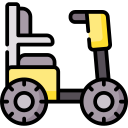
How to Clean Your Electric Scooter: A Friendly, No-Fuss Guide
Chosen theme: How to Clean Your Electric Scooter. Learn the safest, simplest methods to keep your scooter spotless, efficient, and ready to ride—without risking water damage. Follow along, share your own tips, and subscribe for more smart, real-world care advice.
Preparation: Tools, Safety, and Setup
Grab microfiber cloths, a soft detailing brush, a bucket, pH-neutral bike cleaner, isopropyl alcohol, cotton swabs, silicone-safe protectant, and nitrile gloves. These gentle, proven supplies keep finishes safe while lifting grime effectively. Save this list and share any add-ons you swear by.
Preparation: Tools, Safety, and Setup
Switch the scooter off, remove the battery if it is designed to be removable, and cap the charge port securely. Cover displays, throttles, and lighting seams with painter’s tape to block drips. Keep water far from controllers, connectors, and any open gaskets during the entire process.


Dry Cleaning First: Dust, Grit, and Debris
Use a clean, plush microfiber to gently lift loose grit from the stem, deck, and fenders. Light, repeated passes work better than pressure. Think of it as dusting a camera lens—patient, careful strokes protect the finish and set the stage for a safer wet clean.

Wet Wash Without Worries: Frame, Deck, and Wheels
Dilute a pH-neutral cleaner in warm water, lightly dampen a sponge, and wring thoroughly. Clean from handlebars downward so dirt does not travel onto finished areas. Rinse the sponge frequently, keeping drips away from seams. Slow, controlled passes beat heavy sprays every time.
Wet Wash Without Worries: Frame, Deck, and Wheels
Use a firm brush and a small amount of cleaner, scrubbing in short strokes to lift grime from the grit without saturating the deck. Blot dry immediately. Avoid slick soaps that leave residue. If you have a favorite grip-clean formula, share the brand for others to test.


Brakes, Bearings, and Motor: Sensitive System Care
Disc rotors deserve isopropyl alcohol only
Use isopropyl alcohol on a lint-free cloth to degrease rotors thoroughly, keeping sprays and oils far away. If squeal persists, lightly scuff the pads with fine sandpaper and re-bed the brakes with controlled stops. Got a squeal fix we missed? Share it to help the community.
Sealed bearings and folding joints
Do not flood bearings. Wipe their surrounds carefully and avoid pressure that can push water past seals. After drying, add a tiny drop of silicone-safe lubricant to folding pivots only. Skip general-purpose penetrants on bearings. If you notice play or grinding, schedule service promptly.
Hub motors and cables stay dry
Avoid water jets near hub motors, axle nuts, and cable grommets. Clean the exterior with a barely damp cloth and finish with a dry wipe. For heavy mud, let it dry, then brush gently. Inspect cable strain reliefs, and comment if your model has known leak-prone spots.


Drying, Protection, and Shine
Blot with fresh towels, then use low-pressure, cool air to lift moisture from bolt heads, deck edges, and under fenders. Let the scooter sit in moving air briefly. Avoid blasting air into bearings. A careful dry reduces corrosion and next-day mystery squeaks dramatically.
Drying, Protection, and Shine
Apply a silicone-safe protectant to plastic and painted areas, never to rotors, pads, or tire tread. Buff to a subtle sheen that repels dust and water. This hydrophobic layer slows grime buildup and helps UV resistance. Share your favorite finish—matte, satin, or glossy?
Make Cleaning a Habit: Schedules and Shortcuts
After rain or dusty rides
Wipe the scooter within a few hours to prevent mineral spots and corrosion. Focus on fasteners, deck edges, and the braking system. Re-lube pivot points sparingly. Keep a compact towel and brush in your backpack so maintenance becomes a quick, satisfying ritual.
Weekly five-minute routine
With the battery off, dust the stem, spot-clean the deck, and wipe rotors with alcohol. Check tire pressure and bolt tightness. Spin wheels to listen for rubs. These tiny habits extend component life. If you find shortcuts, share them and subscribe for more micro-routines.
Seasonal deep clean and inspection
Quarterly, inspect brake pads, tire tread, and valve cores; clear lint from controller areas if accessible. Check folding hardware for wear and torque to spec. Replace tired grips or fenders. Keep a maintenance log, and tell us which tasks made the biggest difference for you.
